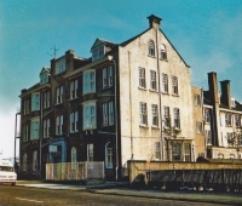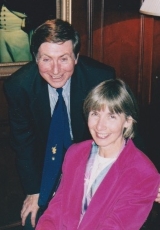Rheumatology
In the adverse social climate in Glasgow in the early 1960s, with no designated rheumatology service, rapid disease progression in, for example, rheumatoid arthritis (RA) with resulting disability was frequently seen.

The Rheumatic Diseases were a neglected area of research and clinical management in the West of Scotland until Miss Margaret Herbison, MP for North Lanarkshire and Minister of Pensions in Harold Wilson’s government, campaigned in Westminster for more than five years for a Glasgow Rheumatology unit. Her efforts were finally rewarded when the Centre for Rheumatic Diseases (CRD) was opened in 1965. The 1965 Western Regional Health Board publication reports that the cost of refurbishment of the Building, at 35 Baird Street, previously used as a reception house for infectious diseases, was £130,000! The hospital was commonly known as “Baird Street”.
Dr Watson Buchanan
Dr. Watson Buchanan was the charismatic and energetic senior lecturer in the University of Glasgow appointed to lead the new service. The new unit was part of the University Department of Medicine, Royal Infirmary, with Professor Edward McGirr as the head of department. Watson Buchanan and his team established an ethos, which has endured over the ensuing 50 years, to study and understand the complex and fascinating rheumatic disorders, and to improve standards of care for rheumatic disease patients.

In many respects, the CRD was a pioneering institution in which clinical excellence and medical innovation came together, driven by curiosity and by a determination to improve patients’ lives.
Co-operation with laboratory colleagues was a prominent early feature of the CRD, and the regional immunology laboratory was situated on the top floor of Baird Street, which was run by Professor Roddy MacSween and then by Professor Keith Whaley, from the department of Pathology at the Western Infirmary.
Watson Buchanan recruited an extraordinary group of doctors and allied health professionals to work with him. In the early days these included:
- Dr Tony Boyle
- Dr George Nuki (later Professor of Rheumatology at Edinburgh)
- Dr Jeremy Saklatvala (later Professor of Biochemistry at the Kennedy Institute of Rheumatology in London)
- Dr Carson Dick (NHS consultant)
- Ms Dorothy Ritchie
Ritchie, an occupational therapist, was the lead author on one of the most cited papers in rheumatology which described what became known as the Ritchie articular index, a measure for the assessment of joint tenderness in patients with rheumatoid arthritis.
Late referral and long neglected inflammatory disease meant that management of disability was the main focus of CRD in the early years. As orthopaedic input was vital, a small operating theatre was set up on the top floor of Baird Street. Many patients underwent bilateral hip and knee replacements, and later, as expertise evolved, shoulder, elbow, hand, foot and neck surgery.
Fundraising in the fledgling department of rheumatology provided much needed money to enhance services for patients and to sustain ongoing research effort over five decades. Many doctors from around the world visited the unit and spent some time training in rheumatology. The number of research papers produced from the unit was prodigious.
When Watson Buchanan emigrated to McMaster University in Hamilton, Ontario, Canada in 1979, the unit lost an inspiring teacher who had succeeded in conveying his own unquenchable intellectual curiosity and enthusiasm to those privileged to work with him.
GRI unit
In 1979, Roger Sturrock was appointed Senior Lecturer and Hilary Capell NHS Consultant in CRD. The unit moved from Baird Street to Glasgow Royal Infirmary in June 1984. There, close collaboration with colleagues in other disciplines was valuable in dealing with co-morbidities such as sepsis, gastro-intestinal morbidity from non-steroidal anti-inflammatory drugs (NSAIDs), and premature cardiovascular morbidity and mortality. Controlling inflammation with ‘disease modifying agents’ became a key aspect, and facilitated a significant reduction in NSAID prescription.

With only two consultants in CRD throughout the 1960s, 1970s and 1980s, facilities for patients with rheumatological diseases remained far short of the British Society for Rheumatology recommendations.
Campaigns to promote the establishment of posts in surrounding areas and prevent long distance travel for patients eventually yielded results, and rheumatology units were established by emissaries trained at the CRD in:
- West Glasgow (at Gartnavel Hospital) in 1977 (Patrick Rooney then John Hunter),
- Ayr in 1979 (Peter Reynolds),
- Inverness in 1985 (Malcolm Steven)
- Lanarkshire in 1987 (Asad Zoma)
These appointments led to a demonstrable reduction in cross boundary flow and distances patients needed to travel.
Roger Sturrock was appointed the first holder of the ARC McLeod chair of Rheumatology in 1990 and at that time Professor AC Kennedy was the Muirhead Professor of Medicine at the Royal Infirmary. Within CRD, in the 1990s, the appointments of Max Field (Senior Lecturer), Rajan Madhok (NHS consultant) and Iain McInnes (Senior Lecturer in Rheumatology and Immunology) increased staffing to five consultants, and both the capacity and the diversity of the unit were greatly enhanced.
Across the years, patients with musculoskeletal diseases were the central focus of investigation of evolving treatment options, and their willingness to co-operate with rheumatology research projects has been remarkable.
Generations of health-care professionals from Scotland, the United Kingdom and beyond have contributed to the high quality of clinical care, training and research. Metrology input to patient evaluation, which had been initiated by Watson Buchanan, was refined, developed and extended by Hilary Capell. Meticulous study documentation was of course central, but the additional dimension of clinical metrologists able to provide for patient care proved invaluable in the functioning of CRD over the following decades.
Redesign of the clinical service led to increasing emphasis on day and outpatient care along with targeted intra-articular corticosteroid injections (latterly under ultrasound guidance where needed).
The establishment of specialist nurse and physiotherapy posts, with space for concomitant day ward services, transformed patient care. These specialist practitioners worked tirelessly to deliver a modern flexible service which has greatly improved patient care and made inpatient treatment a rarity.
Recently, Mhairi Brandon was appointed the unit’s first consultant physiotherapist. In 2008 and 2009, both Hilary Capell and Roger Sturrock retired and David McCarey and Sarah Saunders were appointed as NHS Consultants, Stefan Siebert as Senior Lecturer, and Nicola Alcorn as Associate Specialist. Iain McInnes was appointed to be Professor of Experimental Medicine in 2002, and pioneered basic science research in CRD in both rheumatoid arthritis (RA) and psoriatic arthritis, with a programme of translational cytokine research.
The unit has subsequently published widely in this field and hosts a trials unit specialising in the use of biologic agents in early inflammatory arthritis. Professor McInnes was appointed as director of the School of Infection and Immunity in the University in 2010, Muirhead Professor of Medicine in 2012, and Arthritis Research Professor of Rheumatology in 2014.
The CRD has contributed towards many strands of practice in the current remarkable changes in the treatment of arthritis, especially since the turn of the century. In the evolution of novel treatment strategies, optimisation of drug management, and recognition of the importance of co-morbidities (especially in the vascular system), this has permitted the development of interventions that have saved many lives over the years.
More recently, as the scope of activities in CRD has grown to embrace the excellent basic science in the University of Glasgow, have come invaluable contributions to knowledge of the underlying pathology of musculoskeletal diseases, especially of RA and the spondyloarthropathies (joint disease of the spine).
New targets and new biomarkers are emerging which provide promising opportunities for the future. Research into cytokines to target for future therapies has opened new avenues, and as this exciting field has continued to evolve, biologic therapies have become more widely available.
Steady progress in the range and efficacy of available therapies over the past 25 years has meant that improvements in outcomes have also been observed in ankylosing spondylitis and juvenile idiopathic arthritis. Patients with systemic sclerosis and systemic lupus erythematosus (SLE) are beginning to show improved outcomes after many years of meticulous work caring for individuals, refining assessments and evaluating therapies for these complex conditions. Partnerships with colleagues in Glasgow Caledonian and Strathclyde Universities have added and continue to supplement CRD research efforts so that they span a truly multi-disciplinary spectrum.
The unit has benefited from the generosity of funders in the Research Councils, Government, industry and charitable sectors. The Scottish government funded several major RA therapy studies from the late 1990s onwards. Following on from these studies, collaborative clinical research in Scotland has taken a step forward with the establishment of the Scottish Collaborative Arthritis Research Network (clinical lead Duncan Porter in Gartnavel Hospital and co-ordinator Ann Tierney in Glasgow Royal Infirmary).
A Scottish wide database was also set up for Ankylosing Spondylitis (SIRAS) with the department of Epidemiology at the University of Aberdeen (Professors Roger Sturrock and Gary Macfarlane). Several studies are in progress under this umbrella, with funding from Arthritis Research UK along with a contribution from the pharmaceutical industry. These multicentre studies allow important clinical questions to be addressed without unrealistic restrictions on enrolment and are hence more relevant to Scottish clinical practice.
Between 1987 and 2014, Arthritis Research UK provided funds of £17.5 million for research projects/fellowships in CRD. Their most recent investment has been into the Rheumatoid Arthritis Pathogenesis Centre of Excellence, a project run jointly by the Universities of Glasgow (headed by Iain McInnes), Birmingham and Newcastle. Part of the £2.5 million funding allows for the recruitment of PhD students and post doctoral researchers who will spend time in at least two of the three partner units, thus enhancing communication between the three university hubs. This research aims to elucidate mechanisms behind the development of RA, which should in turn lead to more effective treatments in the future.
CRD consultants have contributed over five decades to the working groups and committees of Arthritis Research UK, including education, research, clinical trials groups and scientific co-ordinating committees.
There has also been a major input into the British Society for Rheumatology and all leading rheumatology journals. The CRD is proud to be a European League against Rheumatism Centre of Excellence, reflecting international recognition of the sustained excellence of Glasgow’s outputs and contribution. Much has been achieved since the creation of the unit in 1965, and the CRD continues to push back the boundaries of research and treatment of the rheumatic diseases. More to be done
Non quia difficilia sunt non audemus, sed quia non audemus, difficilia sunt
It is not because things are difficult that we do not dare, but because we do not dare that things are difficult
Seneca, Letters to Lucilius, letter 104, section 26, line 5
(This article is based on a paper in the Scottish Medical Journal, 2015, Vol. 60(3) 105–107)
Professor Roger D Sturrock
Images provided by Professor Sturrock

